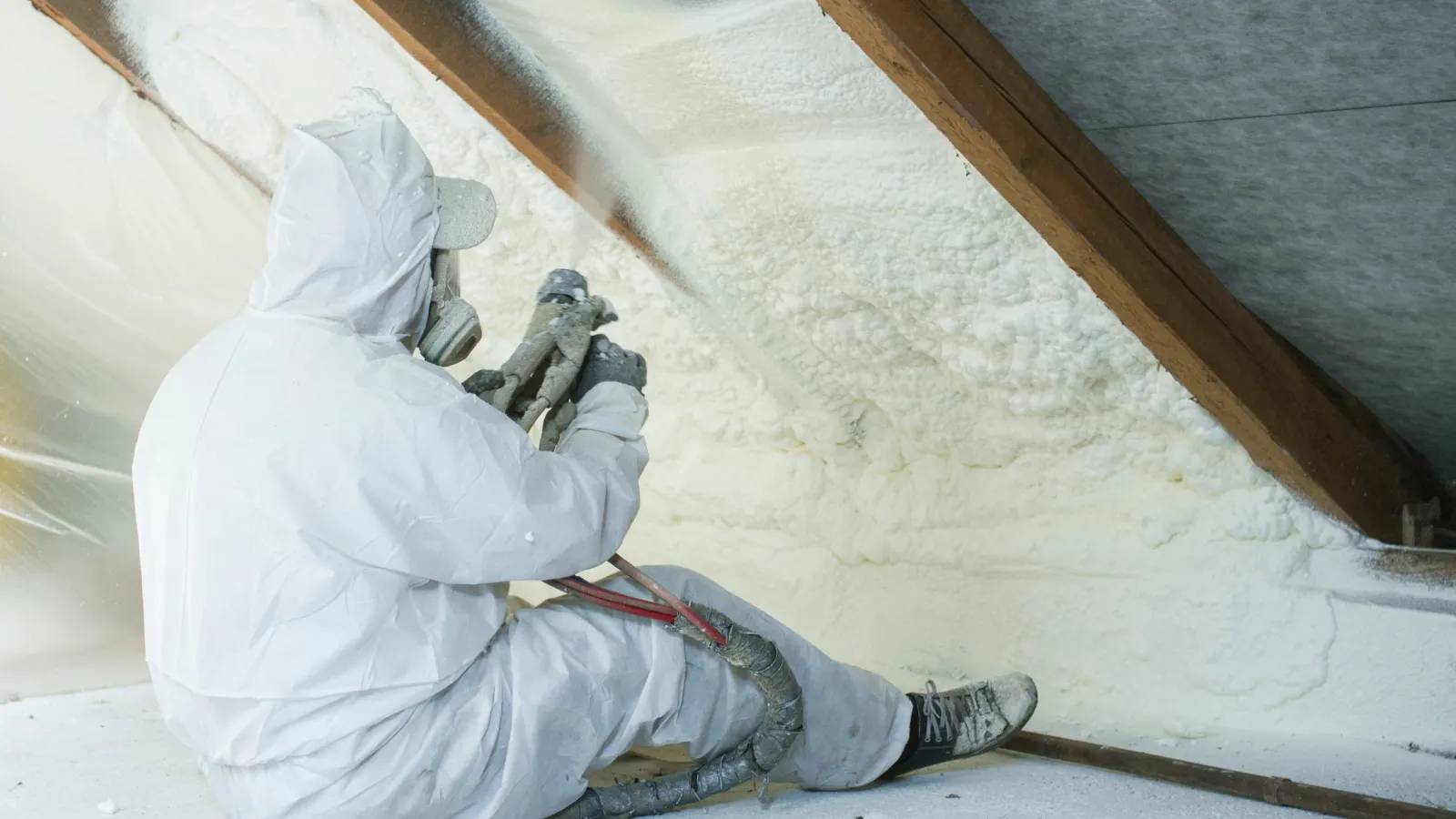What is Spray Polyurethane Foam (SPF)?
Spray polyurethane foam (SPF) is an innovative insulation material with superior thermal resistance and air-sealing properties. Unlike traditional insulation materials like fiberglass and cellulose, SPF is applied as a liquid and expands into a thick foam, creating a continuous barrier against heat, air, and moisture.
How Does SPF Work?
SPF starts as a liquid that is sprayed onto surfaces such as walls, ceilings, and floors. As it is applied, it quickly expands to many times its original size, filling cracks and crevices to form an airtight seal. This expansion creates a high R-value (a measure of insulation's effectiveness), providing exceptional thermal resistance and reducing energy loss.
SPF Insulation: Applications and Best Practices
Attics and Roofs
In the attic, SPF insulation can be sprayed directly onto the roof deck, filling gaps and creating an airtight seal. This application prevents heat from escaping in the winter and entering in the summer, keeping your home comfortable year-round.
Basements and Crawl Spaces
Basements and crawl spaces are notorious for energy loss and moisture problems. Applying SPF insulation to these areas can significantly improve energy efficiency and moisture control, preventing issues such as mold growth and dampness.
Walls and Ceilings
SPF insulation can be sprayed into wall cavities and ceilings, providing a seamless barrier against air leaks. This application is particularly beneficial in unfinished spaces where traditional insulation methods may be challenging to implement.
Spray Foam Insulation Benefits
Some of the benefits of Spray Foam Insulation include energy savings on your bill, increased comfort in your home, improved indoor air quality, and enhanced structural integrity.
Air Sealant
Spray foam expands to fill cracks and holes and, once hardened, creates an airtight seal that blocks particularly cold and hot air from entering, preventing indoor drafts.
Weather Barrier
Year-round, rain or shine, a protective layer of spray foam insulation keeps the elements out and your heated and cooled air in. Spray foam insulation also blocks allergens from entering your home, keeping you comfortable year-round.
Vapor Retardant
Moisture is no match for our spray foam. The material's low permeance or "perm" makes it very effective at lessening the amount of vapor that passes through. And because spray foam won't deteriorate over time, your home will stay protected against moisture and vapor.
Eco-Friendly
Spray foam can help reduce your energy consumption and carbon footprint, protect the environment and boost your overall home comfort, all while limiting the amount of ozone-depleting substances.
Mold Deterrent
Inert polymers prevent bacteria growth and act as a barrier against external moisture. These properties provide better protection against mildew, mold, and water damage.
Sound Suppressor
Once spray foam insulation is installed, you will notice an immediate and significant decrease in outside noises.
What are the Downsides Of SPF?
While SPF insulation offers numerous benefits, including high R-value and excellent air sealing capabilities, it also has some downsides that homeowners and builders should be aware of:
Change in Air Exchanges
SPF spray foam creates a highly effective air barrier, significantly reducing the number of air exchanges in a building. While this improves energy efficiency, it can also lead to poor indoor air quality if the ventilation system is not properly adjusted. Reducing air exchanges can trap indoor pollutants, allergens, and moisture, leading to potential health issues and mold growth.
HVAC Challenges
The airtight seal created by SPF spray foam insulation can also impact the performance of the HVAC system. The reduced airflow, ventilation and addition of the now conditioned attic space may cause the HVAC system to operate less efficiently or become undersized if it is not recalibrated to accommodate the new insulation levels. This can lead to uneven heating or cooling, increased energy consumption, and potential strain on the HVAC equipment.
Fire Retardant Requirement
In some instances, to meet building code requirements, SPF spray foam must be covered with a fire retardant coating or a thermal barrier. This is because the foam is highly flammable and can emit toxic fumes when exposed to high temperatures. The additional step of applying a fire retardant adds to the installation time and cost.
Alteration of the Building Envelope
SPF spray foam insulation alters the building envelope by creating an airtight seal. While this can improve energy efficiency, it can also negatively affect the building's natural ventilation. Without proper ventilation, the airtight environment can lead to poor air quality, moisture problems, and potential structural damage over time.
Exothermic Reaction
Applying SPF spray foam involves an exothermic chemical reaction, which generates heat. If the foam is applied too thickly or too quickly, it can cause the temperature to rise to unsafe levels, potentially leading to the foam igniting or damaging nearby materials. Proper application techniques and experience are essential to prevent such issues.
What Are The Best Alternatives to SPF Spray Foam Insulation?
Several effective alternatives can provide similar benefits in scenarios where SPF (Spray Polyurethane Foam) insulation might not be ideal.
One recommended process involves first extracting the old insulation to ensure a clean and effective installation of new materials. After the old insulation is removed, air sealing services are performed to close any gaps, cracks, or openings in the building envelope, enhancing the insulation's overall efficiency. Finally, loose-fill fiberglass insulation is blown in to provide comprehensive coverage.
This method offers excellent thermal performance, is non-combustible, and can be more cost-effective than SPF spray foam. Loose-fill fiberglass also has the added advantage of being less disruptive to indoor air quality and easier to apply in hard-to-reach areas.
Why Choose USA Insulation for Your Insulation Needs?
At USA Insulation, we specialize in providing comprehensive insulation solutions tailored to your specific needs. These solutions ensure optimal energy efficiency, comfort, and safety for your home or business.
Our expert team utilizes the latest technologies and best practices to deliver superior results, whether through traditional methods like fiberglass or advanced options like spray foam. We always prioritize your satisfaction and the integrity of your building.
Our Commitment to Excellence
- Expert Installation: Our trained technicians ensure precise and thorough insulation installation for maximum effectiveness.
- High-Quality Materials: We use only the best products to ensure long-lasting performance and customer satisfaction.
- Comprehensive Service: We provide a seamless and stress-free experience from initial consultation to post-installation support.
Conclusion
Spray Polyurethane Foam (SPF) insulation provides superior thermal resistance, energy efficiency, and air sealing by expanding to fill gaps and creating an airtight barrier. However, it comes with downsides like reduced air exchanges, HVAC challenges, the need for fire retardants, alteration of the building envelope, and exothermic reaction risks.
Alternatives such as removing old insulation, air sealing, and using loose-fill fiberglass offer effective, cost-efficient solutions with improved indoor air quality and easier application.
At USA Insulation, we offer tailored insulation solutions using high-quality materials and expert installation to ensure optimal energy efficiency, comfort, and safety for your home or business, delivering superior results and a seamless experience



